Feral horse FAQs
What are feral animals?
Feral animals are non-native (introduced) species that are, or have the potential to become, established in the wild through escape from captivity, deliberate or accidental release and accidental or illegal importation. They are also referred to as pest animals or invasive pest species.
In Australia, feral animals typically have few natural predators or fatal diseases, and some have high reproductive rates. As a result, their populations have not naturally diminished. Feral animals can multiply rapidly if conditions are favourable.
Why is Parks Victoria managing feral animals?
Parks Victoria has clear legal obligations to protect and manage Victoria’s natural environment, and specifically the parks estate. These obligations are set out in a range of legislation including the Parks Victoria Act 2018, the National Parks Act 1975 (Vic), the Flora and Fauna Guarantee Act 1988 (Vic), the Environment Protection and Biodiversity Conservation Act 1999 (Cth), and the international Ramsar Wetlands Convention.
Under the National Parks Act 1975, section 17(2)(a), Parks Victoria is obliged to act “for the protection and preservation of indigenous flora and fauna”, and to “exterminate or control exotic fauna” in the parks estate. Parks Victoria also complies with a range of Government policies and decisions regarding the protection of Victoria’s parks and reserves.
Feral animals have no place in Victoria’s nature. Where possible, Parks Victoria will work to remove feral animals from parks. Where this is impractical due to the extensive ‘foothold’ that some feral animals have established, Park Victoria works to keep feral animals to as small a population as possible.
Feral animal control programs are just one way that Parks Victoria takes care of Victoria’s parks. To learn more, visit Conserving our parks.
What are the impacts of feral animals on our environment?
Australia's native plants and animals have adapted to life on an isolated continent over millions of years. Since European settlement native animals and plants have been consumed by or had to compete with a large range of introduced species for habitat, food and shelter.
These pressures have also had a major impact on our country's soils, waterways and marine ecosystems.
What is a feral horse?
‘Feral horses’ refers to horses or populations of horses that have escaped domestication or are descended from domesticated individuals. It is used in a similar context to other invasive species, such as feral goats. Horses are not native species in Australia, only arriving in the past 200 years.
The name ‘brumby’ is an Australian term for feral horses, its use dating back to the 1870s. Much of the Alps was initially grazed without fences, so it was common for domestic horses to escape pastoral properties or be intentionally released.
What is Parks Victoria doing about feral horses in parks?
Feral horses only occur in two Victorian parks - the Alpine National Park and Barmah National Park.
Parks Victoria aims to reduce the numbers of feral horses in parks, to protect the natural environment and provide a greater chance of survival for native species, many of which are found nowhere else on the planet. Parks Victoria has clear plans and programs for feral horse management in the two impacted parks.
Visit Feral Horses for more information.
Note: To protect the safety and welfare of Parks Victoria staff, contractors and community members, operational details (such as timing and location of feral horse control operations) are not publicly released.
Why is Parks Victoria managing feral horses in parks?
Parks Victoria is under the same legal obligations for feral horses as with any other feral animal.
Parks Victoria has a legal and moral obligation to protect Victoria’s natural environment and native species, some found nowhere else on the planet, which are being harmed by the impacts of feral horses.
They are considered a serious threat to the survival of a number of threatened wildlife and plant species, as well as to native ecosystems - particularly high-country peatlands, mossbeds and snowpatch plant communities in the Alpine National Park and Moira floodplain marshes in Barmah National Park.
Parks Victoria has an obligation to reduce the abundance of feral horses in Victoria’s national parks to meet obligations under the Parks Victoria Act 2018, National Parks Act 1975 (Vic), Flora and Fauna Guarantee Act 1988 (Vic), Environment Protection and Biodiversity Conservation Act 1999 (Cth), and the international Ramsar Wetlands Convention.
How is Parks Victoria managing feral horses in parks?
Feral horses are being removed from parks through targeted ground-shooting by professionals under strict protocols and oversight, and trapping and rehoming, where feasible, safe and humane to do so, and where there has been sufficient demand from organisations or individuals that can suitably care for the captured horses.
Between January 2020 and October 2024 a total of 711 feral horses have been removed from Barmah National Park using the methods approved under the Strategic Action Plan: Protection of floodplain marshes in Barmah National Park and Barmah Forest Ramsar site [2020-2023], which includes trapping and rehoming, or ground shooting as well as euthanasia following veterinary welfare checks. During this time an additional 39 trapped horses were refused by rehomers and had to be released back to the park, as the only safe and humane option under the circumstances.
In addition, staff located some carcasses following the floods of October 2022, which indicated that at least 96 horses had potentially drowned during the emergency.
Between January 2020 and October 2024, a total of 1436 feral horses have been removed from the Alpine National Park including the Bogong High Plains and the eastern Alps, using the methods described in the Protection of the Alpine National Park: Feral Horse Action Plan 2021, which includes trapping and rehoming, and ground shooting.
Aerial shooting may be considered in exceptional circumstances or may be trialled if other methods fail to remove sufficient horses to reduce ecological impacts, however aerial shooting has not been used in Alpine or Barmah national parks to date.
All feral horse management operations are thoroughly planned and implemented under strict protocols and oversight, ensuring that operations are safe, effective, humane and meet obligations of all relevant legislation, Codes of Practice and Standard Operating Procedures.
Information can be found in these detailed management plans: Barmah Strategic Action Plan and Protection of the Alpine National Park: Feral Horse Action Plan 2021. These plans are based on long-term scientific evidence and have been developed through extensive consultation with government agencies, Traditional Owner groups, community members, environmental groups and other stakeholders.
Note: To protect the safety and welfare of Parks Victoria staff, contractors and community members, operational details (such as timing and location of feral horse control operations) are not publicly released.
When is feral horse management happening in parks?
Planning and implementation of the feral horse management program is underway and will be ongoing.
To protect the safety and welfare of Parks Victoria staff, contractors and community members, operational details (such as timing and location of feral horse control operations) are not publicly released.
Who is involved in the management of feral horses in parks?
Parks Victoria employs specialist contractors to undertake feral horse management operations, with support from Parks Victoria staff.
Horse groups, animal welfare organisations and professional operators have also been engaged by Parks Victoria in capture and rehoming efforts.
Parks Victoria determines which feral horse management techniques are most suitable using evidence from expert scientists and consultation with government agencies, Traditional Owners, community members, environmental groups and other stakeholders.
How many feral horses are there in Victoria?
Due to the size, remoteness and difficulty of accessing parks where horses occur, counting every horse is not possible. Instead, various internationally-recognised scientific methods are used to determine horse numbers from the monitoring that can be undertaken.
From the most recent surveys, it is estimated that there are approximately 600 horses in Barmah National Park, approximately 100 horses on the Bogong High Plains are of the Alpine National Park, and approximately 5,000 horses in the Eastern Alps section of the Alpine National Park.
See Victorian surveys on feral horses for more detail and explanations of the survey methods and results.
Is Parks Victoria planning to remove all feral horses from all protected areas in Victoria?
No.
Feral horses are only present in the Alpine and Barmah national parks.
As feral horses are so well-established in the remote terrain of the eastern Alps, they are unlikely to be completely removed. The aim is to reduce the population of feral horses to provide a greater chance of survival for rare and threatened native species, many of which are found nowhere else on the planet.
Parks Victoria plans to remove entire isolated populations of feral horses. This includes from the Barmah National Park, as stated in the Barmah Strategic Action Planand existing management plans, and for the small numbers (approximately 100) remaining on the Bogong High Plains in the Alpine National Park. As detailed on page 3 of the Feral Horse Action Plan 2021, Parks Victoria will aim for a significant reduction in the Eastern Alps horse population, with a target of removing 500 horses 2021-22.
Will Parks Victoria use helicopters to shoot horses?
Aerial shooting may be considered in exceptional circumstances, or may be trialled if other methods fail to remove enough horses to reduce environmental impacts.
Any aerial shooting operations targeting feral horses in Victoria will draw on data from other aerial animal control programs, including standard operating procedures and animal welfare considerations from programs in other parts of Australia.
Aerial shooting from helicopters is considered to be effective in reducing the abundance of horse populations in remote and inaccessible locations and where horse densities are high.
It allows shooters to locate and get in close range to the horse (even in remote terrain), quickly cull animals, and if necessary, pursue and kill wounded animals. In 2023, the NSW National Parks and Wildlife Service commenced using aerial shooting to reduce the horse population in Kosciuszko National Park, and it continues to be a primary control method for extensive feral horse populations in Northern Territory, Queensland and Western Australia.
More detail about aerial shooting as a control method is available in the 2005 report by Norris, A, and T. Low, Review of the management of feral animals and their impact on biodiversity in the Rangelands: A resource to aid NRM planning, Pest Animal Control CRC Report 2005, Pest Animal Control CRC, Canberra.
Why can’t feral horses stay in protected areas?
For millions of years, Victoria's native plants and animals evolved to survive in our unique environments, without the impacts of feral animals. Victoria’s native plants and animals, many of which are found nowhere else on the planet, are not equipped to deal with the impacts of non-native species.
Horses are not a natural part of the Australian environment. Their hard hooves can cause serious damage to native plants, animals and sensitive ecosystem. Their grazing and impacts destroy habitat critical to many threatened plant and animal species by damaging waterways, degrading fragile vegetation and disturbing soil to cause erosion and compaction.
What damage do feral horses cause?
Feral horses are not native to Victoria or Australia.
Over the last 200 years, feral horses and other hard-hooved animals such as deer have been brought to Australia and have caused significant harm to native ecosystems, habitats and species, which had evolved on the Australian continent over millions of years.
Feral horses cause damage to Victoria’s natural environment by:
- Grazing and browsing – they consume native plants and destroy the habitat of native wildlife.
- Pugging and streambank collapse – they compact soil, increase erosion, cause wet areas to dry out and degrade waterways.
- Impacting water quality – they remove vegetation, reduce water filtering, cause muddier water and harm native aquatic species.
- Creating trackways – they increase erosion and spread weeds and diseases.
- Trampling and opening of bare ground – they harm soil and plant growth.
- Producing dung piles – that suffocate native plants and aid weed dispersal.
- Spreading weeds – that displace native plants.
- Competing for habitat and food - native animals suffer from damaged habitat and less available food.
- Impacting visitor experience - while some visitors seek or enjoy seeing horses in the Alpine National Park, the presence of feral horse can conflict with other visitors’ expectations of a natural environment and the key features of national parks.
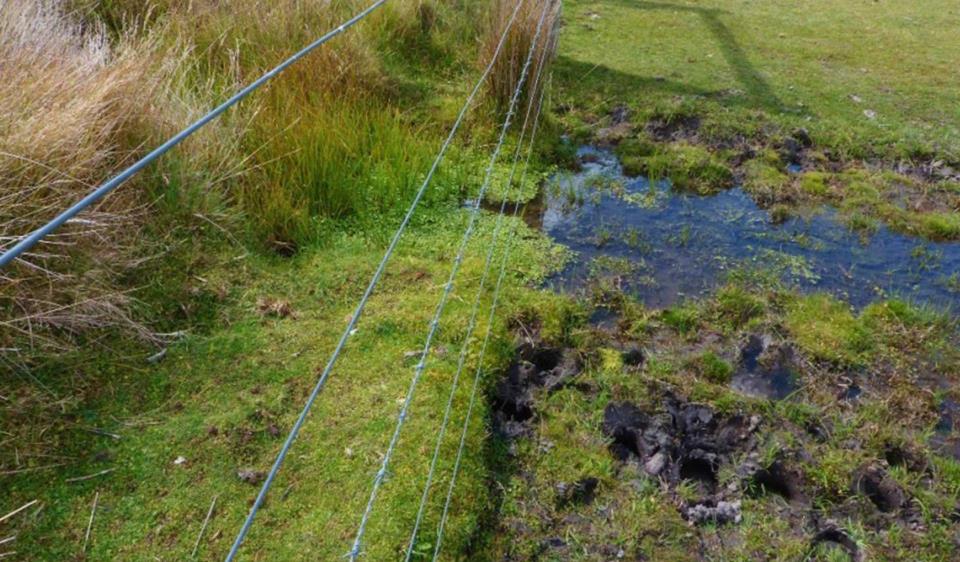
Horse hoof-prints and damage outside an exclosure plot, Alpine National Park
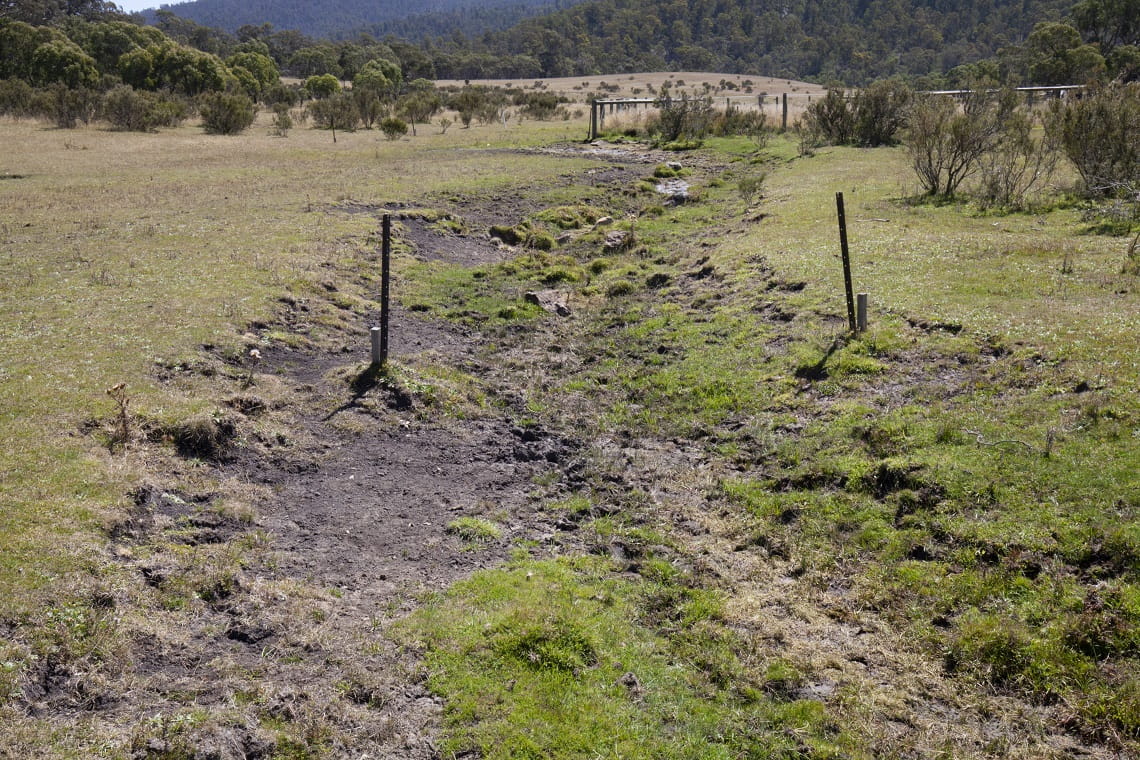
A small stream at the origin of the Murray River, eroded and denuded of vegetation by grazing and pugging by feral horses, Cowombat Flat, Alpine National Park
How do we know that horses are damaging the natural environment?
The scientific evidence of feral horse damage to Victoria’s natural environment is clear, well documented and embodied in legislation.
- See Appendix 1 in the Feral Horse Strategic Action Plan 2018-2021 for a detailed summary of the science related to feral horse impacts on the Victorian Alps.
- Read here evidence from leading Australian scientists clearly demonstrating that feral horses in the Alpine National Park have already caused widespread and, in some cases, irreparable damage to the natural environment.
- Under the National Parks Act 1975, section 17(2)(a), Parks Victoria is obliged to act “for the protection and preservation of indigenous flora and fauna”, and to “exterminate or control exotic fauna” in the park.
- Feral horse impacts of the environment are listed as a ‘threatening process’ under both the Victorian Flora and Fauna Guarantee (FFG) Act 1988 (see Processes List, December 2016) and the Commonwealth Environment Protection and Biodiversity Conservation (EPBC) Act 1999 (see Novel biota and their impact on biodiversity).
- These Acts also acknowledge the precious native species being threatened by feral horses, with the FFG Act listing a number of threatened plants and animals and threatened plant communities as being impacted by horses. Under the EPBC Act, policy statements report that trampling by hard-hooved feral animals, including horses, remains a threat to that wetland community (see Alpine Sphagnum Bogs and Associated Fens Policy Statement 3.16)
Note: The EPBC Act is the mechanism by which Australia enacts the United Nations Convention on Biological Diversity, an international legally binding treaty with an objective to conserve biodiversity.
What native species are harmed by feral horses?
There are more than 300 native fauna species that are being threatened by the impacts of feral horses in Victoria's parks.
These include Smoky Mouse (Pseudomys fumeus), Broad-toothed Rat (Mastocomys fuscus), Dendy’s Toadlet (Pseudophryne dendyi), Alpine Tree Frog (Litoria verreauxii alpina), Alpine Sheoak Skink (Cyclodomorphus praealtus), Alpine Water Skink (Eulamprus kosciuskoi) and Guthega Skink (Liopholis guthega), Alpine Spiny Crayfish (Euastacus crassu) and Alpine and Mount Stirling Stoneflies.
Feral horses also threaten internationally regonised wetlands in the Barmah Forest, very rare alpine and subalpine plants and vegetation communities, many of which support diverse species that are rare and endemic to our parks, including Moira grass plains, alpine sphagnum moss peatlands, snowpatch communities and associated wetland bogs.
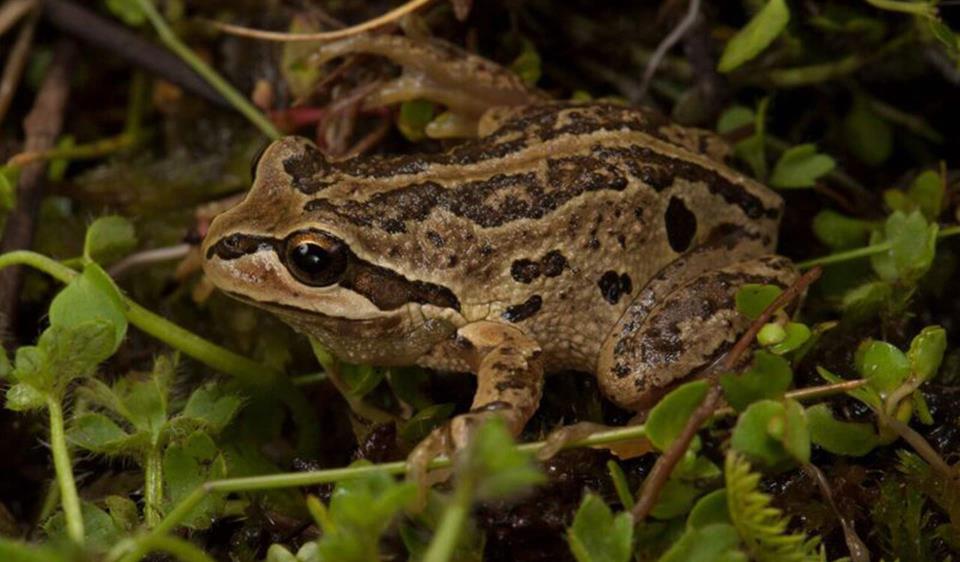
Alpine tree frog (Litoria verreauxii alpina)
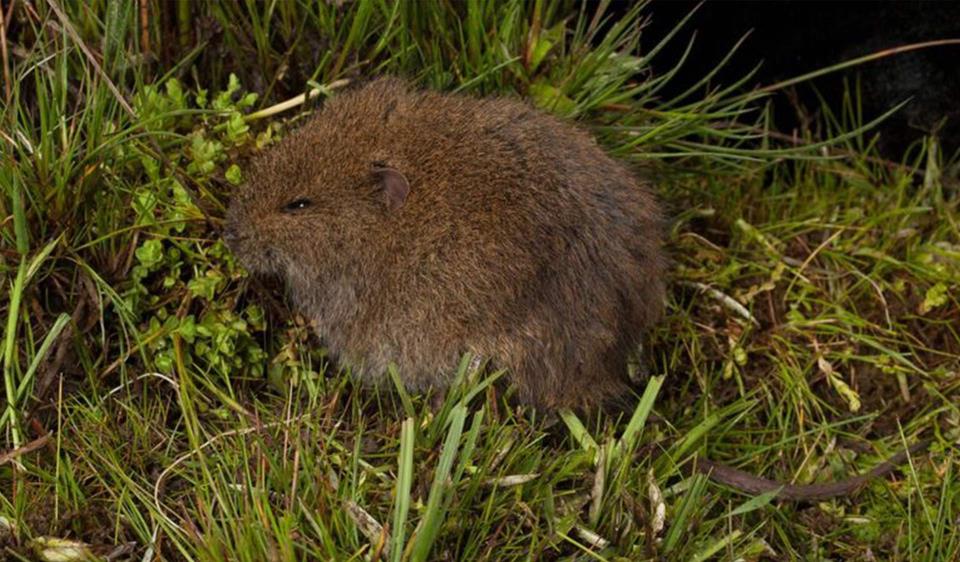
Native Broad-toothed Rat (Mastocomys fuscus)
Are horses heritage listed in Victoria?
No.
In Victoria, feral horses have been formally recognised as a ‘threatening process’ under Victoria’s Flora and Fauna Guarantee Act 1988.
Federal Court judgement on 8 May 2020 found that Parks Victoria’s proposed removal of feral horses from the Bogong High Plains and the reduction in number of feral horses in the Eastern Alps, will not have a significant impact on the National Heritage values of the Australian Alps associated with feral horses and horsemanship.
In New South Wales, the Kosciuszko Wild Horse Heritage Act 2018 recognises the heritage value of sustainable wild horse populations within parts of Kosciuszko National Park and protects that heritage. However, habitat degradation and loss by feral horses is recognised as a ‘threatening process’ under the NSW Biodiversity Conservation Act 2016.
The history of horses is important to some members of the community as a living link to the pioneer and grazing history in the Alps and adjacent cultural lands, and the ‘brumby’ is considered by many to be a part of Australian folklore. However, wild horses are not unique or native to the Victorian Alps, whereas many native species in the Alps are rare and endangered. Parks Victoria therefore has an obligation to protect the native species that are restricted to alpine environments.
Are feral horses descended from horses used in World War I?
Many thousands of Australian stock horses were exported for military use, as mounts for the Australian Light Horse during World War 1, as well as cavalry units from India, New Zealand, Britain and other places. While some of these may have been feral horses, caught and broken in for sale on the war market, they were largely Australian stock horses originally bred for managing stock. Australian stock horses in use today share the same origins as those stock horses exported to war, being bred from their original English, Irish, and Scottish bloodlines to create superb horses for Australian needs and conditions. Of the thousands of horses that went to the Middle East during World War 1, for quarantine reasons, only one was returned.
How will Parks Victoria ensure that removal of feral horses from parks is done humanely?
All feral horse management operations are thoroughly planned and implemented under strict protocols and oversight, ensuring that operations are safe, effective, humane and meet obligations of all relevant legislation, Codes of Practice and Standard Operating Procedures.
Why doesn’t Parks Victoria put a fence around important habitat for native species?
In some places, fences are placed around small vulnerable habitats to collect information on what the environment should look like without grazing, browsing, trampling and other damage from feral animals such as horses, deer and pigs. These are called exclusion areas or exclosure plots.
These exclosure plots are designed to keep feral animals out of small, localised areas, and are not an efficient or cost-effective long-term or large-scale solution.
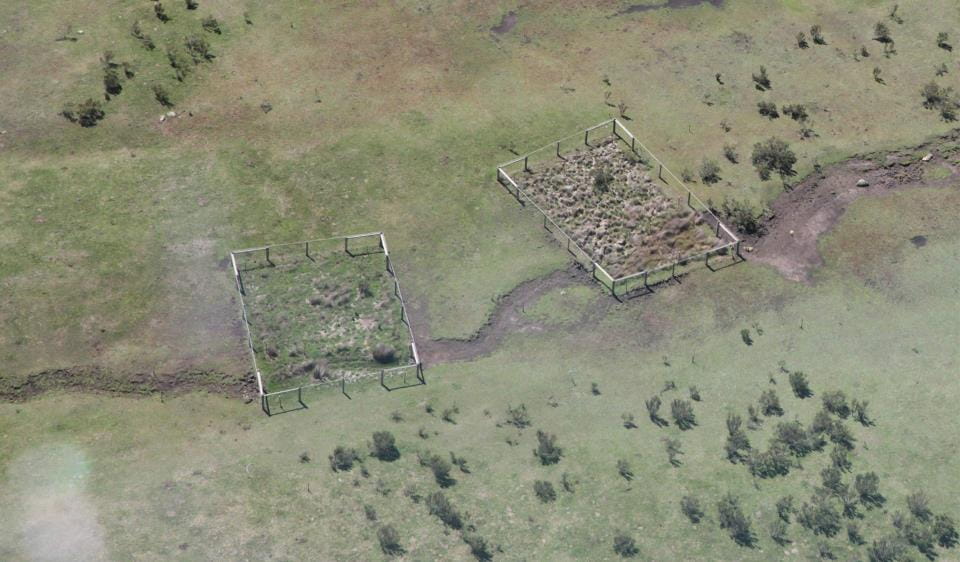
Cowombat Flat, Alpine National Park on 27 February 2020, showing high grazing pressure and waterways damage outside of fenced plots. Approximately 80 horses were observed on the flat on the day this image was taken
Why doesn’t Parks Victoria sterilise feral horses as a control method?
The option of fertility control has been investigated and is not seen as a solution for reducing either feral horse numbers or environmental damage.
In 2018, the CSIRO conducted a study to find out, Could current fertility control methods be effective for landscape-scale management of populations of wild horses (Equus caballus) in Australia?. The answer was no.
Therefore, it is not planned to be used for horse control in Victorian parks, due to the large numbers of feral horses, difficulty in delivering the control agent effectively in the field for large numbers of uncontained and unidentified animals (each mare requiring booster shots every one to two years), the inability for the technique to reduce populations significantly over short to medium timeframes, and the continued environmental damage caused by sterilised animals until they die of old age (up to 20+ years).
How will the public be kept informed of Parks Victoria’s approach to managing feral horses?
Parks Victoria will provide ongoing updates to stakeholders and partners who are assisting in the implementation of the Feral Horse Action Plan 2021 and ongoing actions from the Barmah Strategic Action Plan and its evaluation.
Parks Victoria will also publish relevant updates on the Parks Victoria website.
There are more deer in Victoria than horses. What is Parks Victoria doing about the deer?
Parks Victoria regularly undertakes programs to manage deer, pigs and other non-native species, complementing feral horse management. Feral horse management is one component of an integrated approach to reducing the impacts of introduced animals in the Alpine National Park and Barmah National Park.
As part of the Victorian Government’s emergency response to the impacts of the bushfires on Victoria’s natural environment, an aerial shooting program was undertaken from February 2020 to reduce the impacts of other feral animal species, including deer, feral pigs, goats and foxes. These programs are continuing.
Visit the Deer and feral animal control in response to bushfire webpage for information about this program and links to updates.
Does Parks Victoria permit the use of working dogs in feral horse control operations?
All feral horse management operations are thoroughly planned and implemented under strict protocols and oversight, ensuring that operations are safe, effective and humane.
Parks Victoria will only permit the use of detection dogs in feral horse management operations if they are specifically trained, obedient and non-aggressive (e.g., pointer breeds) and will only be used to detect animals. Dogs are only used in remote areas where detection is necessary.
Dogs will not be used to chase, flush out or attack animals. If dogs are used, care must be taken to prevent injuries and distress, and minimise other risks to the welfare of feral animals.
After feral horse control operations, what happens to the carcasses?
Disposing of any animal carcass in national parks is a challenging issue. In culling large herbivores, standard practice is to leave a carcass where it falls, as it would be if the animal had died by natural causes.
As with all Parks Victoria’s animal control programs, every effort must be made to avoid shooting animals in waterways, close to roads, vehicle and walking tracks and camping areas where carcasses may be visible to the public. They may be covered with vegetation to minimise visual impacts.
Carcasses in waterways, carcasses visible from a road, vehicle track, walking track or camping area will be removed from view if safe and feasible to do so. Chainsaws are not used for carcass management.
Does Parks Victoria control feral horses outside of national parks?
Parks Victoria has clear legal obligations to manage Victoria’s Natural Environment which includes reducing the numbers of feral horses in parks, and provide a greater chance of survival for native species, many of which are found nowhere else on the planet. Parks Victoria has clear plans and programs for feral horse management in the two impacted parks.
Parks Victoria will not control feral horses outside the parks estate, unless agreed to first by the relevant land manager.
Feral horses in the Alpine National Park
What is the Feral Horse Action Plan 2021?
The Feral Horse Action Plan 2021 was developed following several years of engagement with community-based advisory groups, interviews with key peak and regional interest groups, a Victorian community perception survey, and the release of information sheets and background papers.
The preparation of this plan is based on the principles of adaptive management, whereby the knowledge and experience gained from the implementation and review of the Protection of the Alpine National Park – Feral Horse Strategic Action Plan 2018-21 have informed the development of management actions in the current plan. This plan focuses on achieving the objectives laid out in the Greater Alpine National Parks Management Plan (2016), and forms part of the broader multispecies approach to protect the biodiversity of the Victorian Alps. From 26 March to 23 April 2021, a draft of the current plan was released for community engagement, and three main perspectives were evident from the comments provided in both the survey and via written submissions:
(i) Horses are damaging the native environment and should be removed via the control methods outlined in the (draft) revised Plan.
(ii) Horses are causing damage but culling them is not supported.
(iii) Horses are not damaging the native environment and should not be harmed or moved on.
By engaging with the community to develop the plan, Parks Victoria has continued to build understanding, awareness and detailed knowledge of the views in the community on shooting free-ranging horses. These views were considered and balanced in the final plan published in November 2021.
Why doesn't Parks Victoria trap and rehome the feral horses in the Alpine National Park?
Parks Victoria is committed to meeting community demand in providing captured horses to rehoming locations that comply with standards for animal welfare.
The trapping of horses from the Alpine National Park will be dependent on Parks Victoria having secured rehoming opportunities for those horses. Rehoming interest and capacity in the community is critical to a successful rehoming program and Parks Victoria will continue to work with stakeholders to improve rehoming capacity and outcomes.
For detail about rehoming opportunities, please see Rehoming a feral horse.
Why is Parks Victoria planning to shoot feral horses at night?
Targeted ground shooting of free-ranging feral horses by professional shooters is the most humane and environmentally-sensitive way to remove small mobs of feral horses in specific locations.
By undertaking operations at night using thermal imaging and noise suppression, the shooters ensure minimal disturbance for the small mobs of horses. These techniques allow close approach to horses and ensures high shooting accuracy and immediate death for targeted animals.
All feral horse management operations are thoroughly planned and implemented under strict protocols and oversight, ensuring that operations are safe, effective, humane and meet obligations of all relevant legislation, Codes of Practice and Standard Operating Procedures. Expert equine veterinarian oversight for shooting operations will ensure highest welfare standards and outcomes.
Can people continue to ride horses in permitted areas of the Alpine National Park?
Yes.
Parks Victoria has no plans to change arrangements for recreational riding of domestic horses in the Alpine National Park.

